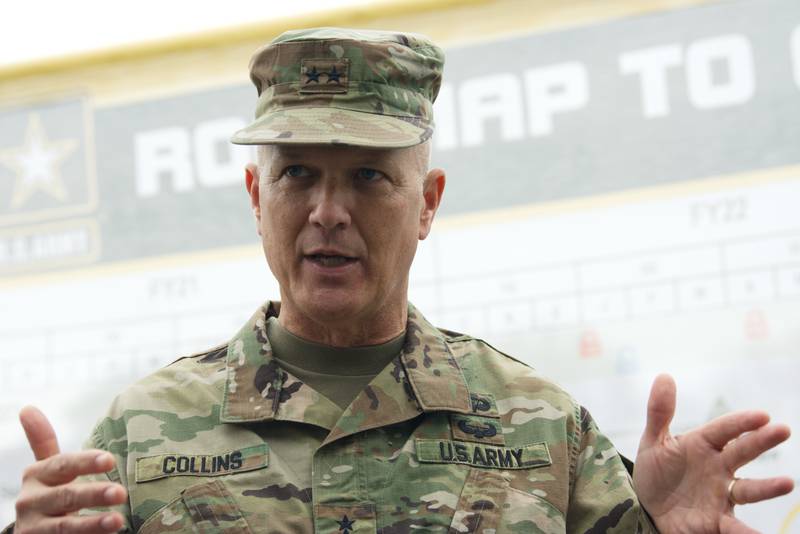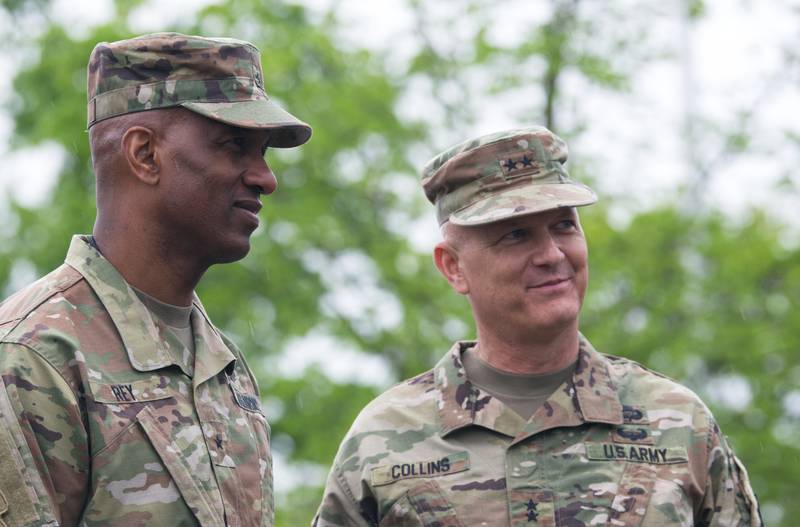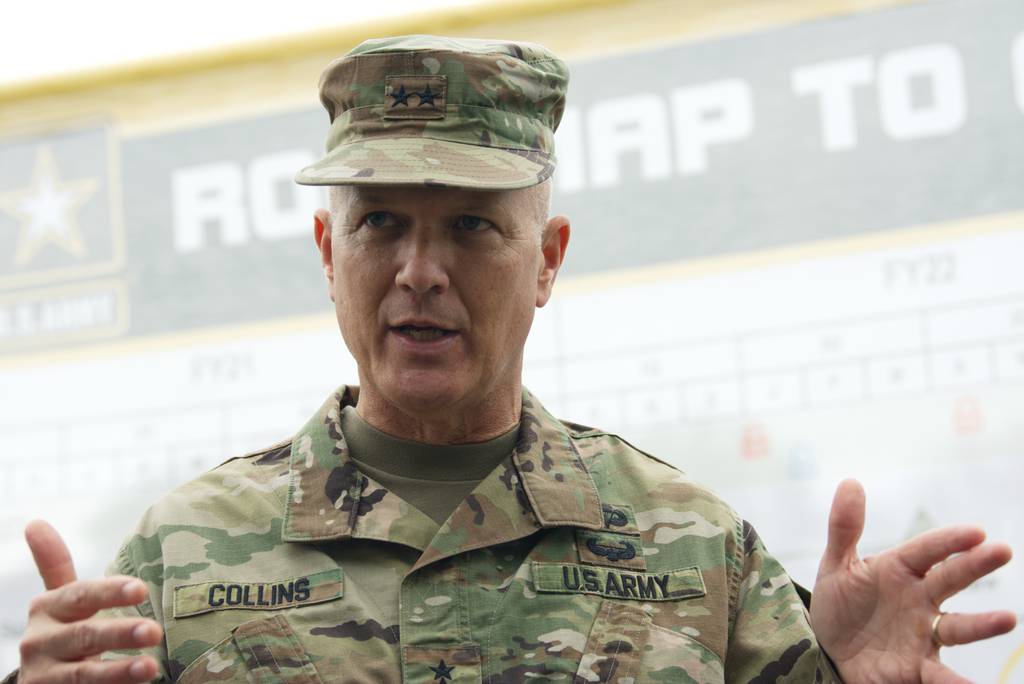WASHINGTON — U.S. Army Maj. Gen. Robert Collins is trading Aberdeen Proving Ground for the Pentagon, after spending a little more than two years working to upgrade the service’s networks and rolling out cutting-edge technology to soldiers.
Collins will leave his post as the program executive officer for command, control and communications-tactical, or PEO C3T, on June 22 to take up the mantle of deputy of acquisition and systems management inside the Defense Department’s Office of the Assistant Secretary of the Army for Acquisition, Logistics and Technology.
There, he will help oversee hundreds of programs and ensure military acquisition goes smoothly.
Maj. Gen. Anthony Potts, who leads PEO Soldier at Fort Belvior, will succeed Collins. He will take the reins of an office he is familiar with, one that sports a multibillion-dollar annual budget and a workforce of more than 1,000 people. The leadership changes were announced in February.
In an interview with C4ISRNET, Collins reflected on his time spent at PEO C3T and considered what’s to come. Portions of the conversation below were edited for clarity and brevity.
RELATED

C4ISRNET: Looking back at the priorities you laid out at the beginning of your tenure at PEO C3T, how do you think you and your team performed?
Maj. Gen. Robert Collins: What I’d say is, although work continues, I think we’ve made a tremendous amount of momentum. I think we’ve made momentum in network readiness, improving our posture for readiness, and then really getting our modernization on a sustainable path toward the Army of 2030.
When I first got here, I had four basic goals.
One was making sure that we ensured a degree of acquisition discipline and enforcing the basics of cost, schedule, performance, risk and ensuring a value proposition, the feedback from the soldier.
Two, I think, given the fact that we are a network, is really honing in on that very tough task of integration and aligning our organization, ensuring we’re properly integrating networks, data analytics, all things from tactical all the way up to the enterprise for the overall integrated, unified — what’s become known as the unified network approach.
I think third was, for me, stakeholders and partnerships, whether it’s engagement forums or enduring relationships.
Wrapping it all around with my No. 1 priority has been leadership and people, and that’s everything from helping retain, recruit, development, talent management, coaching, all that. So that’s been my goals, and I really think we’ve made a tremendous amount of momentum on all four of those.
Along the lines of execution, for Capability Set ‘21, we’re well over three-quarters of the way fielded, and it’s making a difference. In fact, myself and Brig. Gen. Jeth Rey were just over in the European theater and it is over there operationally employed.
Second, Capability Set ‘23. We got through the preliminary design, we got through the critical design, and we’ve just finished up the ops demo with the 2nd Cavalry Regiment over in Europe. It’s been tremendous. And then we really set the design goals and got science-and-technology transition plans and industry focused on Capability Sets ‘25 and ‘27.
C4ISRNET: Did your time at PEO C3T reinforce the capability set approach — compounding tech improvements introduced every two years — as the right one for critical modernization work?
Collins: Yes, I think so.
Iterative and not singular or Big Bang theory is absolutely the way to go, certainly for something that is advancing as quickly as things are related to the IT or digital arena.
Some of the other things have been not just the iterative aspects, but adhering to an open systems type of an architecture, where we can add to new technologies from smaller, more innovative businesses, leverage commercial, leverage non-developmental. I think open systems has been a key tenet.
I think the iterative process is only successful as long as we maintain a kind of a soldier-centric design process. We always ask ourselves basic, basic questions: Is it firm requirements, firm concepts? Maturity? Is it affordable? Is it aligned with something that a soldier would employ on the battlefield? So, I think all those things have been good.
The other thing that we’ve learned through this iterative process is this is a team sport.
We’ve really got a great group. Gen. Rey with Army Futures Command is focused on the what. Joe Welch within the C5ISR science and technology, the art of the possible. And then we here, at the PEO, are focusing on the how.
RELATED

C4ISRNET: What, in your eyes, is that next big leap forward for network modernization? What is that next big “wow” that will make a difference for soldiers or the military, broadly?
Collins: There are already some things that we’re laying the foundation for the “wow.” And I think it’s certainly starting, because, again, this will not necessarily be a Big Bang theory.
But the things that I’m excited about are really in this arena of transporting our data, being transport agnostic, leveraging the multitude of space, air tier, ground. Even within space, there’s low-Earth orbit, mid-Earth orbit or the high orbit.
So to be able to access all that for assured communications and have that be able to route intuitively, and automatically, without any interface for the soldier I think is going to be pretty exciting and a leap ahead.
I think, second, we’re going to get away from this permissive network environment, where we go from allow all, deny by exception to deny all, allow by exception, what we call zero trust.
Then, certainly all of our focus on the data itself. How do we persist it? How do we ingress and egress it, secure it, make it available? And then do so not only at the enterprise, but do it more in a mesh, hybrid environment down at the tactical environment, and then take advantage of cloud.
There are certainly other things as we harness the data. Artificial intelligence has a lot to offer, whether it’s aiding the decision cycle, whether it’s nominating course of actions or course of action recommendations, military decision making, intelligence, battlefield surveillance. I think for artificial intelligence, there’s an unlimited set of opportunities. And then there’s a lot going on in software.
I would say there’s a lot of leap-ahead. There’s a lot of “wow.” Some of it’s already happening now.
C4ISRNET: What’s one piece of advice, or maybe a heads-up, you’d leave behind for your successor?
Collins: I’ve been in the Army 30-plus years, and I always think that the Army does a phenomenal job at selecting the right person at the right time for the right job.
Maj. Gen. Potts is truly a strategic and critical thinker, a team builder. He comes from PEO Soldier; he understands the modernization instrument and how it runs, and he certainly understands that the centerpiece of our modernization is our soldiers.
So I would just continue the momentum building on relationships, partnerships and all of the focus on people for recruiting and retention to maintain our high-quality workforce. But Gen. Potts is going to do phenomenally well, and I look forward to watching this organization continue to thrive and deliver much-needed capability out to our Army.
RELATED

C4ISRNET: You’re headed to the Pentagon as the deputy of acquisition and systems management. What are your plans? What are you hoping to accomplish?
Collins: So, the Collins family is thankful and very excited and very humbled to continue serving in the U.S. Army. I’ve been doing this for 30 years, and any time the coach puts you back in for a couple more plays on the playing field, I’ll tell you, that gives you a lot of energy. That’s point No. 1.
Secondly, I am looking forward to being a contributing member of a very high-caliber ASALT force that Assistant Secretary of the Army for Acquisition, Logistics and Technology Doug Bush has put in place.
I think some of the things that I’ll be focusing on is, one, helping him as we execute our timely and responsive acquisition. Two, embracing some of our new acquisition approaches. Three, we’re trying to enhance the security aspects of our programs, making sure that we protect technology, we cyber harden.
I’ve already mentioned four: our partnerships and teamwork across the broader enterprise. And then certainly, most importantly, our people, maintaining positive climate, developing, mentoring, coaching, and just making sure that we not only recruit, but that we retain world class talent.
Colin Demarest was a reporter at C4ISRNET, where he covered military networks, cyber and IT. Colin had previously covered the Department of Energy and its National Nuclear Security Administration — namely Cold War cleanup and nuclear weapons development — for a daily newspaper in South Carolina. Colin is also an award-winning photographer.








